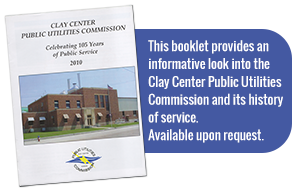
History

With Clay Center Mayor George Hanna as a driving force, city council held a special meeting in 1905 to discuss a municipal light plant. Council then submitted two proposals to the public for approval. First, they proposed to issue bonds in the amount of $20,000 for 10 years at four percent to build a light plant. Second, council proposed to establish a Board of Public Utilities to operate and manage the plant.
In 1906, voters approved both measures. Voters were called upon again to pass additional bonds after the city realized that $20,000 in funding was not enough. The issue passed and a total of $45,000 in bonds were issued to fund the construction of a municipal power plant.
Williamson asked for a court injunction to prevent the city from issuing the bonds.
On July 7, 1907, City Council adopted a resolution which notified F.L. Williamson & Company to discontinue providing service to the city. Council also instructed Williamson to take down and remove all of its poles, wires, and electric materials from the streets, alleys, and public grounds of the city. If Williamson did not comply, the city warned that they would be compelled to do the removal themselves in order to erect municipal poles and wires.
Williamson refused to remove the light poles and wires from Clay Center's streets and alleys. Williamson then requested an injunction to keep the city from making the changes and building its own light plant.
The injunction was not issued, but Williamson & Company pursued the charges through the court for several years to come.
Early on the morning of November 15, 1910, a group of citizens, presumably backed by city authorities, cut down a number of Williamson & Company's poles on 5th street. Citizens also cut the cables in several places.
The Daily Republican reported, "The nightriders were out last night, and as a result of their activities, thirteen poles of the electric light company's lines on Fifth St. are down, and the main cable is cut in seven or eight places. The result being to put out of operation every business in the city using electric power and putting half of the town in darkness. This random destruction, with all of its attendant inconvenience and loss to the partons of the [plant] was done by direction of the city authorities, and under the immediate supervision of Marshal Dave Toiles and City Clerk, Guy Martin."
The Times said, "When the cable was first cut the electrician of the Williamson plant came out, saw what was being done, and notified A.L. Williamson, local manager of the Williamson Company. In the excitement, Williamson was reported to have drawn a revolver on Chet Gilbert and to have threatened to shoot 2 of the men. However, he didnt."
In December of 1910, the case was taken to the United States Supreme Court. Mr. Williams was the lawyer for Williamson's Clay Center Light & Power Company and the firm of Dawes & Miller represented the city.
On December 9, 1910, The Kansas City newspaper said, "The Supreme Court action begun yesterday is the latest move in a fight which has been in progress three and a half years. It was that long ago that the franchise of a private company, which had furnished electric light to the city, expired. The contest has been on to determine whether a city could be forced to buy the private company's plant at an exorbitant figure or permit that company to furnish light at its own price. The City of Clay Center didn't believe it was under any such obligation and doesn't believe that the highest court in the land will say so, either."
In January of 1911, F.B. Dawes went to Washington, D.C. to argue the case before the Supreme Court. The case remained in the Supreme Court for several years.
In 1916, the landmark decision was handed down in favor of Clay Center.
The Topeka Capital reported, "Municipal ownership won an important victory in a decision of the Supreme Court...in the case of the City of Clay Center against the Clay Center Light & Power Company. The court holds that the 21-year franchise of the company has expired and that the city is not compelled either to purchase the plant or renew the franchise."
The 1916 Supreme Court decision was a major step forward for public power, and paved the way for other municipalities to own and operate power plants.
History of the Water Plant
A water plant was originally established with private capital as a pumping plant. In 1883, 65 citizens petitioned the Clay Center City Council for a water works system. The City Council held a special meeting and met with representatives of the Holly Water Works Company of New York. In December of 1883 Clay Center accepted Holly Water Works proposal and the council passed an ordinance granting franchise. The franchise carried certain provisions which included the construction of the plant and the laying of water lines. In April of 1885 the first water main was under construction. This private water plant was only in operation for 3 years. They were cited for violating the terms of the Ordinance and the contract. The Water Company brought a suit against Clay Center. The United States Circuit Court of Leavenworth, KS decided in the favor of Holly Water Works Company. The City immediately appealed to the US Supreme Court. The case lasted several years as the Holly Water Works began to make settlement offers. Bonds were passed, a settlement was agreed upon, and Clay Center became owner of the private plant.

